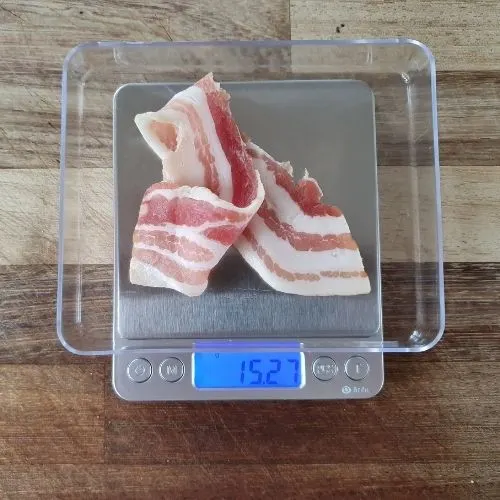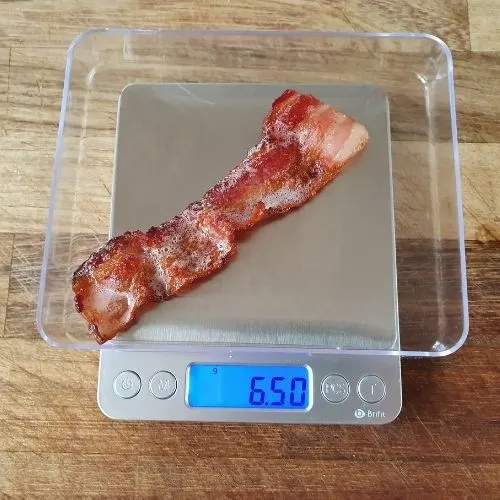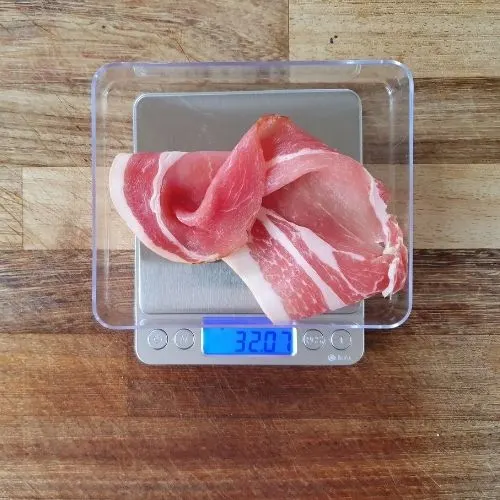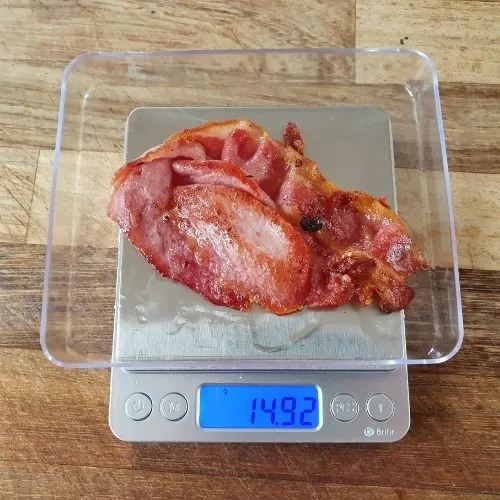Bacon slices can come in various shapes and sizes and there’s also a surprisingly big difference between the weight of raw bacon and cooked bacon. So, if you’re trying to work out the exact weights for cooking or to count calories it can be tricky.
For this article, I’ve tested various types of bacon and put together charts and images so you can easily calculate your weights and calorie counts.
An average slice of uncooked supermarket streaky bacon typically weighs between 15-16 grams (0.53-0.56 ounces). Conversely, a slice of uncooked back bacon, which is often leaner, generally weighs slightly more, coming in at about 32-34 grams (1.13-1.2 ounces). These weights provide a guideline for culinary preparations and nutritional calculations.

Read on to find out more weights of various types of bacon, both cooked and uncooked, along with calorie information for each type and easy-to-follow charts to help you calculate weights correctly.
Uncooked Streaky Bacon Slice Weight and Calories
For this measurement, I used a dry-cured supermarket streaky bacon which is not thick cut. Streaky bacon is a fatty, yet thin cut of bacon.
The calories are taken from the pack nutrition label and are based on 323kcal per 100g.
| Weight Value | |
| Grams | 15-16g |
| KG | 0.015-0.016kg |
| Ounces | 0.53-0.56oz |
| Pounds | 0.033-0.035lb |
| Kcal | 49 (rounded up to nearest 1) |

Cooked Streaky Bacon Slice Weight
This is the same bacon rasher cooked in bacon fat in a pan until the fat rendered down and the bacon went crispy. The bacon reduced by half of its original weight due to fat and moisture loss.
| Weight Value | |
| Grams | 6-7g |
| KG | 0.006-0.007kg |
| Ounces | 0.21-0.25oz |
| Pounds | 0.013-0.016lb |

Streaky Bacon Weights and Calories for Multiple Slices (Uncooked)
The chart below shows the uncooked weight of up to six slices of supermarket dry-cured streaky bacon along with the calorie count (based on the pack information).
Streaky Bacon g to oz
| Uncooked Streaky Bacon | Weight in g | Weight in oz |
| 1 Slice | 15-16 | 0.53-0.56 |
| 2 slices | 30-32 | 1.06-1.13 |
| 3 slices | 45-48 | 1.59-1.69 |
| 4 slices | 60-64 | 2.12-2.26 |
| 5 slices | 75-80 | 2.65-2.82 |
| 6 slices | 90-96 | 3.17-3.39 |
Streaky Bacon Calories (Uncooked)
| Uncooked Streaky Bacon Slices | Calories (kcal) |
| 1 Slice | 49 |
| 2 Slices | 98 |
| 3 Slices | 147 |
| 4 Slices | 196 |
| 5 Slices | 245 |
| 6 Slices | 294 |
Uncooked Back Bacon Slice Weight
For this measurement, I used a dry-cured supermarket back bacon which is not thick cut. Back bacon has more meat than fat when compared to streaky bacon.
The calories are taken from the pack nutrition label and are based on 149kcal per 2 slices.
| Weight Value | |
| Grams | 32-34g |
| KG | 0.032-0.034kg |
| Ounces | 1.13-1.2oz |
| Pounds | 0.07-0.075lb |
| Calories | 75kcal (rounded up to nearest 1) |

Cooked Back Bacon Slice Weight
This is the same bacon rasher cooked in bacon fat in a pan until the fat rendered down and the bacon went crispy. The bacon reduced by half of its original weight due to fat and moisture loss.
| Weight Value | |
| Grams | 14-15g |
| KG | 0.014-0.015kg |
| Ounces | 0.49-0.53oz |
| Pounds | 0.030-0.033lb |

Cooked Bacon Weight V’s Uncooked Weight
Bacon comes in various kinds, but most cuts (with the exception of medallions) are made up of a high percentage of fat.
As the bacon cooks the fat renders down and melts into the pan and the longer it’s cooked the more fat melts away and the crispier the bacon becomes.
Meat also contains water which will evaporate and cause weight loss as its cooked. It’s also worth noting that some bacon has added water which bulks out raw bacon and will cook out in the pan. To avoid cuts with added water it’s a good idea to choose dry-cured bacon.
When I tested the weights of dry-cured bacon before and after cooking, both streaky and back bacon reduced in weight by around 50%. This was mainly due to fat loss, which remained in the pan.
Calories in Raw Bacon v’s Cooked Bacon
The fact that bacon reduces in weight by around 50% which is mainly fat, raises the question of should you use the raw or cooked calorie count to work out exactly how many calories you’re using.
This is a question that is surprisingly difficult to get an answer to, I’ve done a lot of looking and even Government sites don’t state clearly state which weight should be used on labeling.
The supermarket bacon packet from the bacon I weighed, (both cooked and uncooked) stated the nutritional values ‘as sold’, meaning the calories stated on the pack are the raw calories rather than the cooked amount.
If you’re using a calorie tracker such as My Fitness Pal and you’re adding bacon (and other meats) via barcode scan, then chances are it’s the uncooked values you’re using.
This value includes all of the fat which is lost in the pan or grill, which you’re probably not going to be eating.
So, it’s possible that when it comes to bacon you might actually be consuming less fat and calories than you think if you’re using the uncooked values.
Personally, I just use the raw value because any calorie saving is a bonus, but if you’re sticking to precise macros you might need to take this into consideration.
Some people reduce the calories by a certain amount such as 25%-50% of the original value.
How calorie values are listed on packaging might also vary depending on the country of origin along with other factors, so if you’re looking to be precise, it’s always good to check the packet to be sure.
Other Bacon Weight Variations
There are some more bacon weight variations that will impact the weight and calorie count calculation, these include:
- Thick cut bacon – some supermarkets stock thicker cut bacon which weighs more than their standard bacon.
- Bacon medallions – these are lower-fat cuts that are mainly meat, so they shouldn’t reduce in weight as much when they’re cooked.
- Butcher bacon – a butcher will usually slice bacon to their own choice of thickness (unless you request a thinner/thicker slice).
If in doubt and you need the weight for cooking or calorie counting, check the pack or ask your butcher to write the weight on the bag so you can work it out when you get home without needing to weigh it.
More Bacon Weight and Calorie FAQ’s
In the case of supermarket bacon, both smoked and unsmoked versions generally are the same when it comes to weight and calories. However, in some cases, they do add extra ingredients such as maple or sugar to smoked bacon which can make it higher in calories and potentially slightly heavier. It’s a good idea to check the pack for extra ingredients or ask your butcher what’s in their cure.
Although it’s more fatty a cooked slice of crispy streaky bacon has fewer calories than a slice of back bacon. This is because the fat renders down and remains in the pan or grill rather and is not eaten.
Articles You Might Find Useful
I hope this article has helped you to find out more about bacon weights and calories, you might also find the following article helpful too:
Chicken Mini Fillet Weights, Calories & Servings (With Calculator & Charts)
Chicken Wing Weights, Calories & Servings (In Charts)
